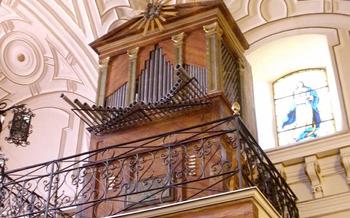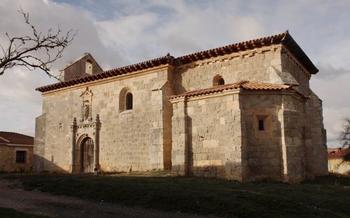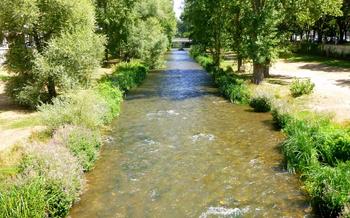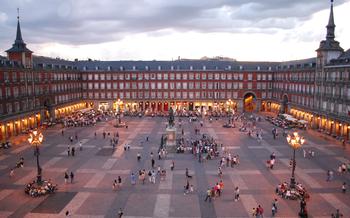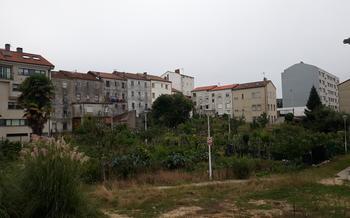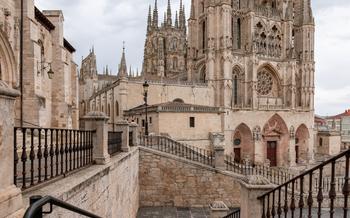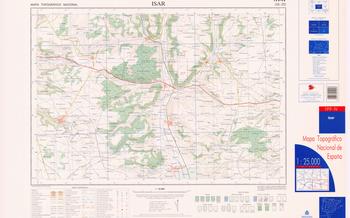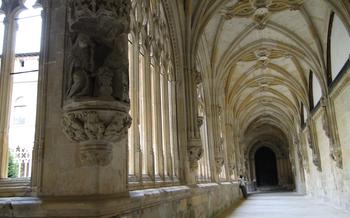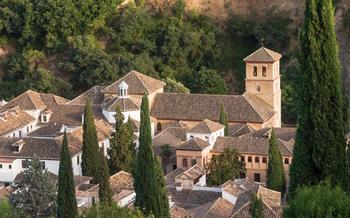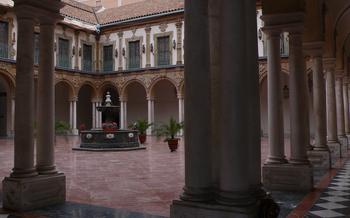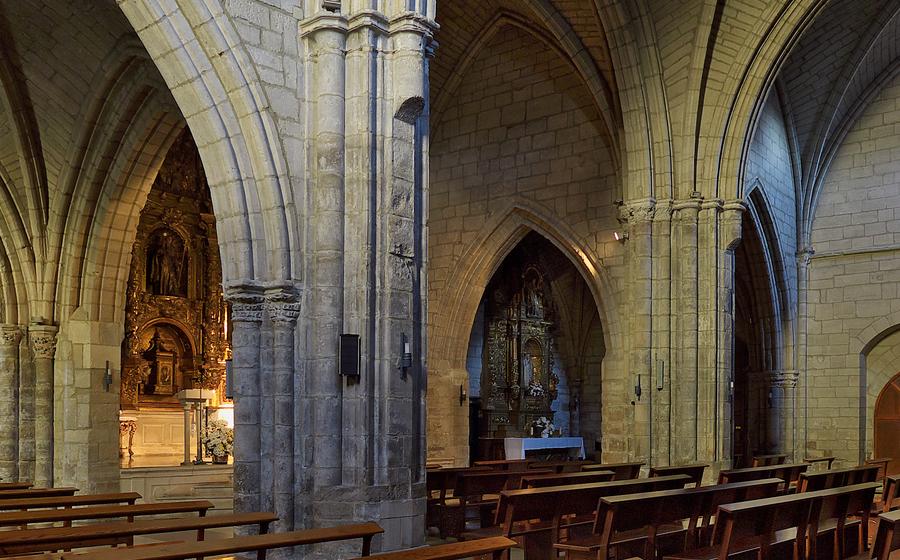
Convento de Santa Clara
- Burgos' Hidden Gem: Convento de Santa Clara
- A Royal Foundation
- Architectural Masterpiece
- The Cloister: A Serene Oasis
- The Church: A Sacred Space
- Tombs of Royalty
- The Legend of the Three Holy Nuns
- Current State: A Cultural Center
- Practical Information
- Location and Contact
- Opening Hours and Admission
- Guided Tours
- Accessibility
- Dress Code and Respect
- Explore the City of Burgos
- Indulge in Local Cuisine
- Pilgrimage Route: Camino de Santiago
- Side Trip to Santo Domingo de Silos
- Insider Tip: Off-Season Visit
Burgos' Hidden Gem: Convento de Santa Clara
Nestled in the heart of historic Burgos, Spain, lies a hidden gem that often goes unnoticed by tourists: the Convento de Santa Clara. Founded by Queen Isabella I of Castile in the 15th century, this remarkable convent boasts a rich history, stunning architecture, and captivating legends. Step inside its ancient walls and immerse yourself in a world of tranquility, spirituality, and royal grandeur.
A Royal Foundation
The Convento de Santa Clara was founded in 1455 by Queen Isabella I of Castile, one of the most influential monarchs in Spanish history. Isabella I, also known as Isabella the Catholic, was a fervent Catholic and a patron of the arts. She envisioned the convent as a place of worship and a mausoleum for her family.
The foundation of the convent was part of Isabella I's broader patronage of the arts and culture. She supported numerous artistic and intellectual endeavors, including the construction of hospitals, universities, and libraries. Her patronage helped to usher in a period of cultural and intellectual flourishing in Spain.
The Convento de Santa Clara was intended to be a royal mausoleum, where Isabella I and her husband, King Ferdinand V, would be laid to rest. The couple had a deep affection for the city of Burgos, and they chose the convent as their final resting place.
The construction of the convent coincided with a period of significant historical change in Spain. The Catholic Monarchs, as Isabella I and Ferdinand V were known, were instrumental in the unification of Spain and the expulsion of the Moors from the Iberian Peninsula. The foundation of the convent reflected the growing power and influence of the Spanish monarchy.
Architectural Masterpiece
The Convento de Santa Clara is a testament to the architectural prowess of the Gothic period. Its intricate details and harmonious blend of Gothic and Mudejar elements create a visually stunning masterpiece. The church's exterior boasts intricate carvings, pointed arches, and flying buttresses, showcasing the quintessential Gothic style. The interior is equally impressive, with its soaring vaulted ceilings, ribbed arches, and stained-glass windows that bathe the space in a kaleidoscope of colors.
The fusion of Gothic and Mudejar elements is evident throughout the convent. Mudejar influences can be seen in the intricate plasterwork, tilework, and decorative elements that adorn the walls and ceilings. The combination of these two architectural styles creates a unique and captivating blend that is both aesthetically pleasing and historically significant.
The historical significance of the Convento de Santa Clara's architecture cannot be overstated. It is a prime example of the architectural transition from the Romanesque to the Gothic period and showcases the evolution of artistic styles in medieval Spain. The convent's well-preserved state makes it a valuable resource for studying the development of architecture during this era.
The Cloister: A Serene Oasis
At the heart of the Convento de Santa Clara lies a tranquil sanctuary—the cloister. Step into this serene space, and you'll be enveloped by a palpable sense of peace and tranquility. Gothic arches, intricate carvings, and a central fountain create a harmonious ensemble that invites contemplation and reflection.
The cloister's serene atmosphere is further enhanced by the delicate interplay of light and shadow that filters through the Gothic arches. As the sun gracefully shifts throughout the day, the cloister transforms into a kaleidoscope of light and shade, casting intricate patterns on the surrounding walls and walkways.
In the center of the cloister, a fountain provides a soothing backdrop to the tranquil ambiance. The gentle sound of water trickling into the basin creates a calming effect, inviting visitors to pause and appreciate the beauty that surrounds them.
The cloister is not merely an architectural masterpiece; it also holds profound symbolic significance. In Christian tradition, the cloister represents a microcosm of the universe, a sacred space set apart from the worldly realm. It serves as a reminder of the spiritual journey that each individual undertakes in their quest for enlightenment and connection with the divine.
The Church: A Sacred Space
The Convento de Santa Clara's church stands as a testament to the grandeur of Gothic architecture. Its awe-inspiring altarpiece, crafted with intricate detail, depicts scenes from the life of Christ and the Virgin Mary. The resplendent stained-glass windows bathe the interior in a kaleidoscope of colors, casting an ethereal glow upon the sacred space.
The church's focal point is its majestic high altar, a masterpiece of artistry. Its elaborate carvings and gilded adornments create a sense of reverence and awe. Here, the faithful gather to offer prayers and seek divine guidance. The church's acoustics lend a celestial quality to the Gregorian chants that resonate within its walls, creating an atmosphere of profound spirituality.
Beyond its aesthetic beauty, the church holds immense religious significance. It serves as a place of worship for the nuns who have dedicated their lives to serving God. The church's hallowed grounds have witnessed countless moments of devotion, contemplation, and spiritual transformation. It is a sanctuary where the faithful find solace, renewal, and a connection to the divine.
Tombs of Royalty
The Convento de Santa Clara is also home to the tombs of two of Spain's most revered monarchs: Isabella I of Castile and Ferdinand V of Aragon, also known as the Catholic Monarchs. Their elaborate effigies lie side by side in a magnificent burial chamber, a testament to their power and enduring legacy.
Isabella and Ferdinand were instrumental in the unification of Spain, the conquest of Granada, and the funding of Christopher Columbus's voyage to the Americas. Their reign marked a period of cultural and intellectual flourishing, and their patronage of the arts and sciences contributed to Spain's rise as a major European power.
The tombs of Isabella and Ferdinand are exquisitely crafted, featuring intricate carvings and lifelike details. The monarchs are depicted in their royal regalia, surrounded by symbols of their authority and faith. The burial chamber itself is adorned with Gothic arches, stained glass windows, and other decorative elements, creating a solemn and awe-inspiring atmosphere.
Visiting the tombs of Isabella and Ferdinand is a poignant experience, allowing visitors to pay homage to two of Spain's most influential rulers and to reflect on their profound impact on the nation's history and culture.
The Legend of the Three Holy Nuns
Local folklore is replete with tales of divine intervention and miraculous apparitions, and the Convento de Santa Clara is no exception. Legend has it that during the construction of the convent, three nuns, known as the Three Holy Nuns, appeared to the workers, urging them to build a cloister in the center of the complex. The nuns vanished as mysteriously as they had appeared, leaving behind a profound sense of awe and wonder.
The workers, heeding the nuns' celestial advice, constructed a magnificent cloister that became the heart of the convent. This cloister, with its serene atmosphere and intricate Gothic arches, is believed to be a testament to the divine intervention of the Three Holy Nuns. Their story has become an integral part of the convent's history, adding a mystical and spiritual dimension to this sacred space.
The legend of the Three Holy Nuns is deeply embedded in the cultural heritage of Burgos, passed down through generations of locals. It serves as a reminder of the deep-rooted faith and belief in the miraculous that have shaped the city's religious and cultural identity.
Current State: A Cultural Center
After centuries of serving as a religious institution, the Convento de Santa Clara underwent a comprehensive restoration in the 20th century. This meticulous process aimed to preserve its historical integrity while adapting it to a new purpose: a vibrant cultural center.
The restoration efforts successfully revitalized the convent's spaces, transforming them into venues for exhibitions, concerts, conferences, and various cultural events. These events breathe new life into the ancient walls, showcasing the enduring legacy and versatility of this architectural masterpiece.
The convent's current state as a cultural center strikes a harmonious balance between its sacred past and contemporary relevance. It continues to honor its religious heritage while embracing a dynamic role in the cultural landscape of Burgos, offering a platform for artistic expression, intellectual discourse, and community engagement.
The transition from a religious institution to a cultural center has ensured the preservation and accessibility of this architectural gem. It now welcomes visitors from all walks of life, inviting them to explore its rich history, admire its stunning architecture, and immerse themselves in the cultural offerings that bring its spaces to life.
Practical Information
Location and Contact
The Convento de Santa Clara is situated in the heart of Burgos, a stone's throw away from the iconic Burgos Cathedral. Its exact address is Calle Doña Jimena 1, Burgos, Spain. For any inquiries or further information, visitors can contact the Convento directly by phone at +34 947 200 280 or via email at [email protected].
Opening Hours and Admission
The Convento de Santa Clara welcomes visitors from Tuesday to Sunday, with varying opening hours depending on the season. During the summer months (April to September), the Convento is open from 10:00 AM to 1:00 PM and 4:00 PM to 7:00 PM. In the winter months (October to March), the hours are slightly shorter, from 10:00 AM to 1:00 PM and 4:00 PM to 6:00 PM. Admission to the Convento is free of charge, allowing everyone to experience its historical and artistic treasures.
Guided Tours
To delve deeper into the Convento's rich history and symbolism, guided tours are available upon request. These tours are led by knowledgeable guides who provide insights into the Convento's architecture, royal connections, and religious significance. Tours can be arranged for groups of various sizes and are conducted in Spanish, English, and French. Advance booking is recommended to secure a spot.
Accessibility
The Convento de Santa Clara is committed to providing an accessible experience for all visitors. The ground floor of the Convento, including the cloister and the church, is wheelchair accessible. However, due to the historical nature of the building, certain areas, such as the upper floors and the royal tombs, may not be easily accessible for individuals with mobility impairments. Visitors with specific accessibility needs are encouraged to contact the Convento in advance to discuss any necessary arrangements.
Dress Code and Respect
When visiting the Convento de Santa Clara, it is important to dress modestly and respectfully. This is a religious site, and visitors should be mindful of the sacred nature of the space. For women, this means covering shoulders and knees. For men, shorts and tank tops should be avoided. Additionally, all visitors should refrain from loud or disruptive behavior, as this may disturb the tranquility of the convent.
The local customs and traditions of Spain should also be respected. For example, it is customary to greet people with a handshake or a kiss on the cheek. It is also important to be aware of the local laws and regulations, such as those regarding smoking and drinking in public places. By being respectful of the local culture and customs, visitors can help to ensure that their visit to the Convento de Santa Clara is a positive and enriching experience.
Explore the City of Burgos
Your visit to Burgos is not complete without exploring other cultural and historical gems the city has to offer. Just a stone's throw from the Convento de Santa Clara, you'll find the majestic Burgos Cathedral, an awe-inspiring Gothic masterpiece with intricate carvings and soaring spires. Its grandeur is sure to leave you breathless.
For a journey into the depths of human evolution, head to the Museo de la Evolución Humana, where fascinating exhibits showcase the incredible story of our origins. Discover the secrets of our ancestors through interactive displays and learn about the remarkable discoveries made in the Atapuerca Mountains, a UNESCO World Heritage Site just outside the city.
Ascend the hill to witness the imposing Castillo de Burgos, a formidable fortress that once served as a strategic defensive structure. Explore its ramparts, towers, and dungeons, and immerse yourself in the tales of medieval battles and sieges that shaped the history of this region.
Indulge in the delectable local cuisine at one of the many traditional restaurants in Burgos. Savor the flavors of Castilian gastronomy, known for its hearty stews, roast lamb, and an array of mouthwatering tapas. Don't miss the opportunity to visit the local markets, where you can find fresh produce, artisanal cheeses, and cured meats that showcase the region's culinary heritage.
Indulge in Local Cuisine
Burgos is a culinary paradise offering a delectable array of traditional dishes that showcase the region's rich gastronomic heritage. Savory stews, such as Olla Podrida, a hearty feast of meats and vegetables, and Lechazo Asado, a succulent roasted lamb, are must-tries. For a taste of local delicacies, head to the bustling markets, where you can sample fresh produce and artisanal cheeses. Don't miss the opportunity to indulge in Morcilla de Burgos, a flavorful blood sausage, and Queso de Burgos, a creamy sheep's milk cheese. Immerse yourself in the local culinary scene by participating in cooking classes or food tours, where you can learn the secrets of traditional Castilian cuisine and savor the authentic flavors of Burgos.
Pilgrimage Route: Camino de Santiago
The Convento de Santa Clara holds a special place in the history of the Camino de Santiago, a renowned pilgrimage route that traverses Spain and ends at the Cathedral of Santiago de Compostela in Galicia. Pilgrims embarking on this spiritual journey often stop in Burgos to visit the convent and pay homage to the remains of Isabella I, a devout Catholic and patron of the Camino. The convent's location on the pilgrimage route adds to its significance, making it a place of both religious and cultural importance.
In the past, pilgrims would flock to the convent seeking spiritual guidance and blessings before continuing their journey. Today, modern-day pilgrims still visit the convent to experience its sacred atmosphere and learn about its historical connection to the Camino. Whether you're a religious pilgrim or simply a curious traveler, visiting the Convento de Santa Clara offers a unique glimpse into the history and cultural significance of the Camino de Santiago.
Side Trip to Santo Domingo de Silos
Just a short drive from Burgos lies the enchanting Benedictine monastery of Santo Domingo de Silos, a hidden gem of Romanesque architecture. Founded in the 11th century, this monastery boasts a remarkably preserved cloister, featuring intricate carvings and vibrant frescoes depicting scenes from the Bible.
Step inside the church and marvel at the grand altar, adorned with polychrome sculptures and intricate gold leaf detailing. Don't miss the opportunity to hear the Gregorian chant performed by the resident monks, a truly unique and awe-inspiring experience that transports visitors back in time.
Santo Domingo de Silos is not just a historical treasure but also a place of profound spirituality. Take a moment to wander through the serene cloister, let the tranquility wash over you, and soak in the centuries of history that permeate this sacred space.
Whether you're a history buff, an architecture enthusiast, or simply seeking a tranquil escape, a side trip to Santo Domingo de Silos is an absolute must. Immerse yourself in the rich cultural heritage of Spain and discover the hidden wonders that lie just beyond the city limits.
Insider Tip: Off-Season Visit
To truly appreciate the serene beauty of Convento de Santa Clara, consider visiting during the off-season, typically from November to March. The absence of large crowds allows for a more intimate and tranquil experience. You can wander through the cloister and church without jostling for space, allowing you to fully immerse yourself in the architectural details and spiritual atmosphere. Moreover, the soft, diffused light of the winter sun casts a magical glow on the monastery, creating stunning photo opportunities. Embrace the tranquility of the off-season to forge a deeper connection with this hidden gem of Burgos.
